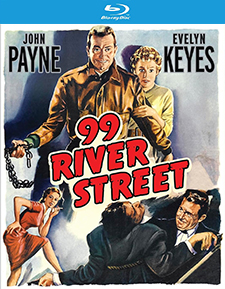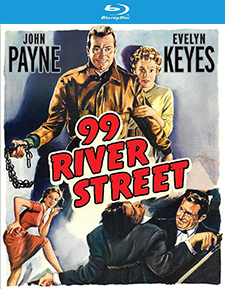99 River Street (Blu-ray Review)

Director
Phil KarlsonRelease Date(s)
1953 (August 13, 2024)Studio(s)
World Films/United Artists (Kino Lorber Studio Classics)- Film/Program Grade: B+
- Video Grade: A-
- Audio Grade: A
- Extras Grade: B
Review
The former boxer is a character familiar in film noir and prominent in such pictures as Night and the City, The Killers and The Set-Up. Once injury ends his boxing career, the fighters left to fend for himself. With no other skill to fall back on, the washed-up pug has to choose either dead-end jobs or crime. 99 River Street relies on this formula.
Champion boxer Ernie Driscoll (John Payne, The Vanquished) takes a rough beating in the middle of a heavyweight title bout and gets knocked down. The referee sees a serious cut over one of Ernie’s eyes, immediately stops the match, and calls it in favor of the opponent. If Ernie fights again, his optic nerve will be permanently damaged. Four years later, Ernie is a cab driver. His wife, Pauline (Peggie Castle, Back from the Dead), is frustrated and bitter that her husband has no prospects other than a generous tip here and there.
Ernie hopes to get himself a gas station one day, but Pauline rages at the idea. At a suggestion from Stan (Frank Faylen, Detective Story), his buddy at the cab company, Ernie buys her a large box of chocolate, but when he brings it to her at the shop where she works, he discovers her in a clinch with another man. On top of that betrayal, his friend Linda (Evelyn Keyes, The Jolson Story) uses him in an elaborate plot to snag the leading role in a Broadway show. This only further bruises Ernie’s ego. He lashes out at her male co-conspirators with his fists and they call police.
These two entanglements get Ernie unwittingly involved with a group of jewel thieves and wanted by the cops for a murder he had nothing to do with, making him a punching bag not only for wife, friends, and enemies, but also for unlucky turns of fate that tend to draw themselves to the down and out. Ernie is collateral damage in the machinations of ambitious women.
Director Phil Karlson provides 99 River Street with twists and surprise revelations; an assortment of low-life thugs, grifters, and schemers; and plenty of darkness and suspense. The waterfront milieu is one of deception, violence, cynicism, and betrayal.
John Payne elicits sympathy as the ego-shattered pug who can’t seem to catch a break. His primary emotion is pent-up seething that sometimes turns explosive. The world hasn’t been kind to Ernie. His big chance at fame and fortune as heavyweight champion of the world ended with a career-killing injury and now, with diminished self-esteem, he has to contend with betrayals by two women he trusted and the consequent pursuit by a violent gang of jewel thieves and the police who suspect him of murder.
Castle is appropriately caustic as Pauline, a woman who wants more than a cabbie can provide. Young, beautiful, shapely, with sex appeal to spare, Castle plays Pauline as impatient and frustrated. She exchanged her initial ambition of making it in show business for a glittering life with a champion fighter, and now she’s left with neither.
Keyes has a big role as Linda, an aspiring actress whose relationship with Ernie is complex. Her performance seems overwrought at times until we realize that she’s playing a potentially career-making role in real life.
As Stan, the always reliable Frank Faylen shares some good scenes with Payne as the voice of common sense. Protective of Ernie and aware of his short fuse, Stan is a calming influence on the former fighter. Brad Dexter (The Las Vegas Story) plays gangster Victor Rawlins, a cold-blooded thug who turns out to be complicit in Ernie’s betrayal. Jay Adler (The Catered Affair) and Jack Lambert (Scared Stiff) are on hand as shady underworld types.
Taking place during one night—except for the ending, which reflects studio interference to conclude on an upbeat note—99 River Street is a fast-paced noir with all the trappings. Director Karlson uses angles to reflect power. As two characters speak, the one with greater power looks down, the other looks up. This subtle technique is used repeatedly throughout the film. A studio back lot stands in for city streets. Other locations include dark alleyways and a long dock with light reflecting off wet sidewalks. The film starts with a bang as we watch the end of Ernie’s milestone bout as his body and his dream come crashing down.
This is low-budget moviemaking at its best. At only 83 minutes, it zips by without a wasted or unnecessarily protracted scene. The structure allows for gradual revelations tossing aside viewer expectations. Director Karlson captures a noir milieu and its one-night time frame adds tension to the narrative. A lot happens in only a few hours and the events are dramatic, involving murder, a frame-up, eluding the cops, dealing with dangerous thieves, all while the main character reckons with his own frustrations and aspirations along with those of the two women in his life.
A major flaw is that Linda attaches herself to Ernie for nearly the entire film. After betraying him to help herself, she becomes his sidekick, helping him to extricate himself from a perilous predicament. This relationship is a contrivance that emerges not from a logical development but from the writer’s desire to establish a bond between Ernie and Linda.
99 River Street was shot by director of photography Franz Planer on 35 mm black-and-white film with spherical lenses, finished photochemically, and presented in the Academy aspect ratio of 1.37:1. Picture quality on the Blu-ray is somewhat soft, with details not as pronounced as in other Blu-rays of period films. However, beads of sweat, costume patterns, wording on the side of cabs, and women’s hair register well. Lighting is noirish and atmospheric. Director Phil Karlson employs lots of close-ups, particularly of John Payne to emphasize Ernie’s simmering anger. A composite shot toward the end of the film is quite poor and actually exhibits flickering where live action and a matte painting join. The staged choreography of the heavyweight fight isn’t as convincing as the fight in a later scene, when Ernie punches the theater people who instigated Linda’s prank. Backlot street scenes are apparent to modern viewers, as are rear projection scenes of car interiors to create the illusion that the vehicle is in motion.
The soundtrack is English 2.0 DTS-HD Master Audio. Available subtitles are in English SDH. Dialogue is clear throughout. Sound effects include car engines, people running, fighters being punched in the ring, Ernie’s sucker punches in the theater, gun shots, police sirens, and general ambient noises of a gym.
Bonus materials on the Region A Blu-ray release from Kino Lorber Studio Classics include the following:
- Audio Commentary by Eddie Muller
- Trailer (2:14)
- The Boss Trailer (1:23)
- Shield for Murder Trailer (1:46)
- Force of Evil Trailer (1:33)
- The Killing Trailer (1:49)
Audio Commentary – Film historian and host of TCM’s Noir Alley Eddie Muller expresses his affection for movies that take place in a single night, as in Deadline at Dawn, Crossfire, and The City That Never Sleeps. The action in 99 River Street—a hard-hitting pulp fiction with “punch and panache”—starts fast with Ernie’s heavyweight fight. Muller says the fight choreography doesn’t look authentic and John Payne can’t camouflage the carefully staged moves. The first reveal of the film is that Ernie is watching the four-year-old bout on TV, reliving his almost-glory day. Street scenes were shot at the Goldwyn Studio. Evelyn Keyes, who was a friend of Muller’s, had no intention of appearing in 99 River Street, but when she read the script, she was impressed with the size of the role and agreed to play it. She met producer Mike Todd at the time and carried on an affair with him for a few years. Brad Dexter’s Rawlins is similar to a part he played in The Asphalt Jungle. His career consisted primarily of roles in crime films and Westerns. The film’s publicity featured the claim, “It rips into you like a double-crossing dame.” The writer’s knowledge of boxing lends verisimilitude to the film. For instance, a court case is cited in which a boxer permanently injured a man in a bar fight and was sentenced to prison. A boxer’s hands, according to the law, are lethal weapons. This is brought out in the film’s dialogue. Producer Edward Small set out to be an actor but became the first agent to represent vaudeville artists. He discovered Clara Bow and “sold” Norma Shearer to MGM. Small made 35 films between 1937 and 1947. He preferred historical films before turning to crime pictures such as Raw Deal, Walk a Crooked Mile, Kansas City Confidential, and 99 River Street. Typical Small pictures cost between $100,000 and $300,000 and were made on a two-week shooting schedule. Payne, more recognizable today for his crime dramas than the musicals that first brought him fame, optioned the Ian Fleming novel Moonraker in 1955. He wanted to both produce it and star as James Bond, but it would take seven years before 007 would debut on the big screen with Sean Connery as Bond.
Taking place in a single night, 99 River Street is taut and brutal. Filled with low-life noir types, it creates palpable atmosphere as it focuses on its deeply flawed hero struggling with anger who lashes out even at those who try to care for him. The film is an unsentimental look at a man whose lack of self esteem and simmering volatility become a destructive combination.
- Dennis Seuling

